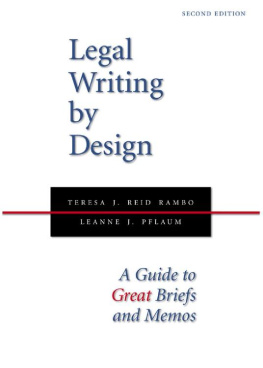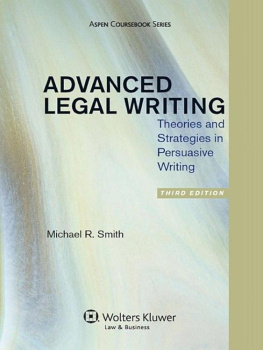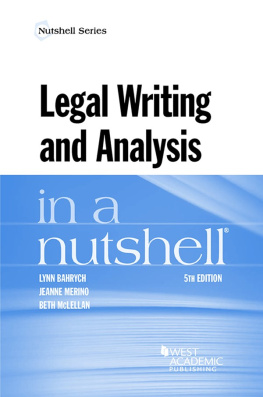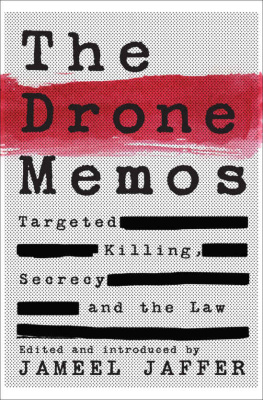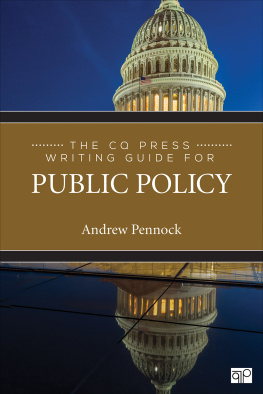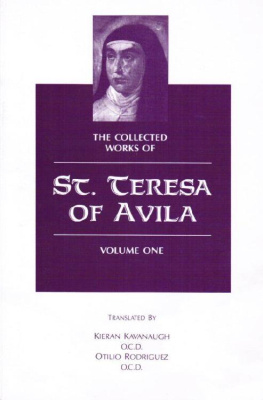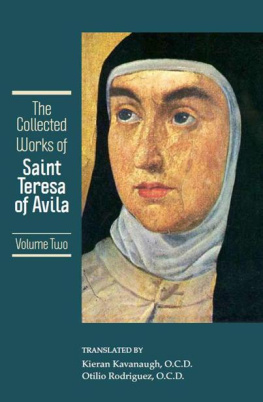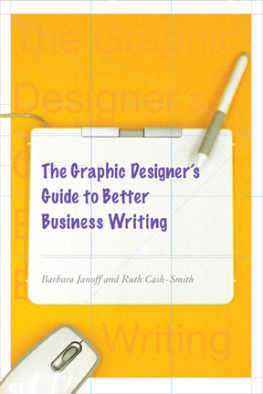Teresa J. Reid Rambo - Legal Writing by Design: A Guide to Great Briefs and Memos, Second Edition
Here you can read online Teresa J. Reid Rambo - Legal Writing by Design: A Guide to Great Briefs and Memos, Second Edition full text of the book (entire story) in english for free. Download pdf and epub, get meaning, cover and reviews about this ebook. year: 2013, publisher: Carolina Academic Press, genre: Romance novel. Description of the work, (preface) as well as reviews are available. Best literature library LitArk.com created for fans of good reading and offers a wide selection of genres:
Romance novel
Science fiction
Adventure
Detective
Science
History
Home and family
Prose
Art
Politics
Computer
Non-fiction
Religion
Business
Children
Humor
Choose a favorite category and find really read worthwhile books. Enjoy immersion in the world of imagination, feel the emotions of the characters or learn something new for yourself, make an fascinating discovery.
- Book:Legal Writing by Design: A Guide to Great Briefs and Memos, Second Edition
- Author:
- Publisher:Carolina Academic Press
- Genre:
- Year:2013
- Rating:3 / 5
- Favourites:Add to favourites
- Your mark:
- 60
- 1
- 2
- 3
- 4
- 5
Legal Writing by Design: A Guide to Great Briefs and Memos, Second Edition: summary, description and annotation
We offer to read an annotation, description, summary or preface (depends on what the author of the book "Legal Writing by Design: A Guide to Great Briefs and Memos, Second Edition" wrote himself). If you haven't found the necessary information about the book — write in the comments, we will try to find it.
Legal Writing by Design: A Guide to Great Briefs and Memos, Second Edition — read online for free the complete book (whole text) full work
Below is the text of the book, divided by pages. System saving the place of the last page read, allows you to conveniently read the book "Legal Writing by Design: A Guide to Great Briefs and Memos, Second Edition" online for free, without having to search again every time where you left off. Put a bookmark, and you can go to the page where you finished reading at any time.
Font size:
Interval:
Bookmark:
Legal Writing by Design
Legal Writing by Design A Guide to Great Briefs and Memos
A Guide to Great Briefs and Memos  SECOND EDITIONTeresa J. Reid Rambo and Leanne J. Pflaum
SECOND EDITIONTeresa J. Reid Rambo and Leanne J. Pflaum Legal Skills Professors,
University of Florida Fredric G. Levin College of Law
 Copyright 2013Teresa J. Reid Rambo and Leanne J. PflaumAll Rights ReservedLibrary of Congress Cataloging-in-Publication DataRambo, Teresa J. Reid.Legal writing by design : a guide to great briefs and memos / Teresa J. Reid Rambo, and Leanne J. Pflaum. -- 2nd ed.p. cm.Includes bibliographical references and index.ISBN 978-1-59460-859-9 (alk. paper)1. Legal composition. 2. Legal briefs. 3. Law--United States--Language. I. Pflaum, Leanne J. II. Title.KF250.R35 2012808.06'634--dc23
Copyright 2013Teresa J. Reid Rambo and Leanne J. PflaumAll Rights ReservedLibrary of Congress Cataloging-in-Publication DataRambo, Teresa J. Reid.Legal writing by design : a guide to great briefs and memos / Teresa J. Reid Rambo, and Leanne J. Pflaum. -- 2nd ed.p. cm.Includes bibliographical references and index.ISBN 978-1-59460-859-9 (alk. paper)1. Legal composition. 2. Legal briefs. 3. Law--United States--Language. I. Pflaum, Leanne J. II. Title.KF250.R35 2012808.06'634--dc23 2012036500
C AROLINA A CADEMIC P RESS 700 Kent StreetDurham, NC 27701Telephone (919) 489-7486Fax (919) 493-5668www.cap-press.comPrinted in the United States of AmericaTo our families for their love and support

Contents
Acknowledgments
For their help and encouragement, we thank Lorraine Reid; Marge Baker; Glenda Sawyer; our colleagues Henry Wihnyk; Betsy Ruff; Patricia Thomson; Diane Tomlinson; Shira Magerman, and students John Giftos; Bridgit Wenz; Lara Parkin; David Maier; and Doron Weiss. Special thanks to students, Monica Haddad and Sandy Chiu, for exhaustive reading and editing of the second edition, and to Kristine Festa and Patricia Rego for research assistance. We are also most grateful to all our students and teaching assistants for encouraging us to write this book, and allowing us to learn from them. Finally, we gratefully acknowledge our publisher's patience in waiting for this second edition.
Copyright AcknowledgmentsOur thanks to the following copyright holders:
Thomson Reuters, for permission to reprint California v. Ciraolo , 476 U.S. 207 (1986) in its entirety with our annotations, and the excerpted cases in the Appendix, all from Westlaw.
Bryant G. Garth & Joanne Martin, Law Schools and the Construction of Competence , 43 J. Legal Educ. 469, 488 (1993). Copyright 1993 by the Journal of Legal Education.
Introduction There was a man who disliked seeing his footprints and his shadow. He decided to escape from them, and began to run. But as he ran along, more footprints appeared, while his shadow easily kept up with him. Thinking he was going too slowly, he ran faster and faster without stopping, until he finally collapsed from exhaustion and died. If he had stood still, there would have been no footprints. If he had rested in the shade, his shadow would have disappeared.Benjamin Hoff, The Tao of PoohThe goal of our book is to help you rest in the shade, at least when it comes to legal reasoning and writing. It's to remind you, in easily understandable terms, that you already know how to reason and how to argue. You've been doing both since you could speak.
We are by nature logical creatures, meeting situations with the memory of how we and others have acted in the past and projecting how we might act in the future. As children, we learned the value of precedent: Well, Matthew got to stay up this late when he was my age , so why can't I? We also learned that there were rules and then there were RULES . Just as it was when we were kids, as lawyers, our goal in employing reasoning in a legal writing format is simple: it's to make a point; it's to get what we want.
We hope to give you the confidence and direction to apply to your legal writing the reasoning skills you've spent your life exercising and mastering. We want to demystify the writing process by explaining the logic of deductive, inductive, and analogical reasoning, and by explaining the concept of relevancy as a link between rule and fact. We present a common sense approach to understanding and structuring legal analysis.
Effective legal research and oral and written communication are core skills every lawyer must master. You don't have to take our word on this. The importance of these goals in your professional careers is corroborated by a survey cited in an article by Bryant G. Garth & Joanne Martin, Law Schools and the Construction of Competence , 43 J. Legal Educ. 469, 488 (1993). That timeless survey asked hiring partners in a large city which skills they expected applicants to bring to the job and which could be developed after hiring. Here are some partial results of that survey:
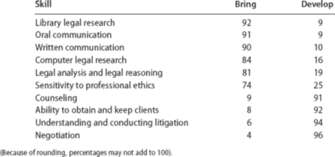
A more recent survey of hiring partners and recruiters in law firms includes writing as one of the five basic skills lacking in new attorneys. No matter how well you know the law, that knowledge alone has little value unless you can communicate it effectively. And, to those of you who may be thinking either: (1) I don't need to learn legal writing because I'm going to be a trial attorney; or (2) I already know how to write, allow us to briefly address these thoughts.
First, even those of you who will be trial attorneys will need to know how to write motions and memoranda of law. Second, even though you already know how to write, you likely don't know how to write legal documents, which have their own special structure, format, and citation requirements.
Indeed, the importance and distinctive requirements of legal writing set it apart from other types of writing. The heightened importance of legal writing derives from the critical impact it can have on the lives of the people who are the subject of such writing. Legal writing requires you to be able to analyze a legal issue and to communicate your analysis to others.
Legal analysis generally takes two forms: (1) predictive analysis, and (2) persuasive analysis. The most common type of document used in predictive legal analysis is the legal memorandum, although a client letter providing an opinion on a legal issue is another. The legal memorandum predicts the outcome (favorable or unfavorable) of a legal question by analyzing the authorities governing the question and the relevant facts giving rise to the legal question. It explains and applies the authorities in predicting an outcome, and ends with advice and recommendations. The legal memorandum also serves as a record of the research done for a given legal question on a certain date. Traditionally, and to meet the legal reader's expectations, it is formally organized and written.
On the other hand, a document employing persuasive legal analysis, generally a motion or a brief, attempts to convince a deciding authority to resolve the dispute in favor of the author's client. Motions and briefs are submitted to judges, mediators, arbitrators, and others. In addition, a persuasive letter might be sent to the opposing parties in a dispute to persuade them to settle the case. Although a brief, similar to a memorandum, states the legal issues, describes authorities, and applies those authorities in analyzing the facts, the brief's discussion section is framed as an argument. The author argues his or her approach for resolving the legal matter, rather than presenting a neutral analysis.
In both situations, whether writing predictively or persuasively, your job is to evaluate the strength of your client's legal situation and to effectively communicate your case. These two types of analysis and writing tend to overlap: to predict an outcome, the writer must recognize both sides of an argument; and to persuade a decision-maker to accept the client's view, the writer must recognize how the argument will be viewed objectively.
Next pageFont size:
Interval:
Bookmark:
Similar books «Legal Writing by Design: A Guide to Great Briefs and Memos, Second Edition»
Look at similar books to Legal Writing by Design: A Guide to Great Briefs and Memos, Second Edition. We have selected literature similar in name and meaning in the hope of providing readers with more options to find new, interesting, not yet read works.
Discussion, reviews of the book Legal Writing by Design: A Guide to Great Briefs and Memos, Second Edition and just readers' own opinions. Leave your comments, write what you think about the work, its meaning or the main characters. Specify what exactly you liked and what you didn't like, and why you think so.

